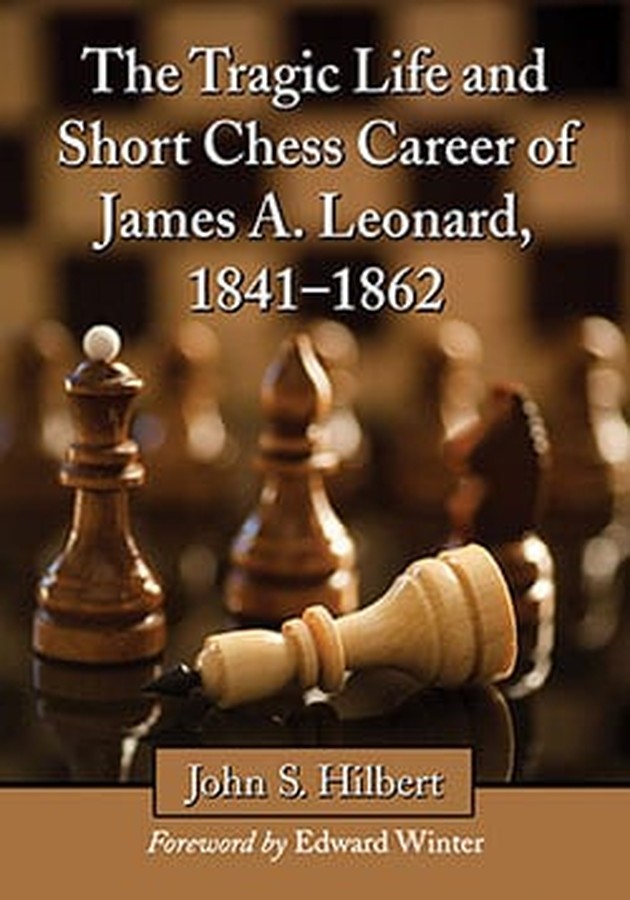| Utgivelsesdato | Mai 2014 |
| Forfatter | |
| Pris | 560 NOK |
James A. Leonard 1841 - 1862
Forlagets egen omtale
Born in 1841, in New York, killed in the Civil War, James A. Leonard was the son of a poor Irish immigrant - but even a poor child could play the game of kings. Leonard grew up in a time when interest in chess was experiencing a revival, and Paul Morphy had captured nation's interest. Leonard defeated a number of the country's notable chess players and was widely viewed as the "New Morphy." Game scores and diagrams from 96 of Leonard's games are included.________
The Civil War affected the entire American landscape in ways not always given their due consideration. Not only did it determine the political future of a nation, it influenced the scientific and cultural development of the country as well. The war cost America many of its best and brightest in every venue. James A. Leonard was one such loss: a brilliant up-and-coming chess player in 1861-62 before he made the decision to serve his country during wartime.
Born November 6, 1841, James A. Leonard was the son of a poor Irish immigrant-but even a poor child could play the game of kings. Leonard grew up in a time when interest in chess was experiencing a revival, and contemporaries such as Paul Morphy, Eugene Delmar and Leonard’s mentor Philip Richardson captured the interest of a country. Leonard defeated a number of the country’s notable chess players and was widely viewed as the “New Morphy.&rdquo
This biography discusses what little is known of Leonard’s life and death but concentrates primarily on Leonard’s ability and his sadly shortened career. Game scores and diagrams from 96 of Leonard’s games are included, with detailed descriptions regarding place, date and opponents.
Foreword:
The chess historian is a free agent who may go wherever he pleases, constrained only by the wish, and need, to present something fresh. If his specialty is biography, for instance, he may choose to focus on a well-known master, but will then delve deeply, going far beyond the well-trodden path. Alternatively, and sometimes even more satisfyingly, he may select a figure never previously accorded full-scale biographical treatment.
Until recently, the name of James Leonard was unfamiliar to most chess enthusiasts. There were occasional references in passing to a brilliant young blindfold expert viewed as a possible successor to Paul Morphy, but scant particulars were readily available about him. His name did not appear in chess encyclopedias, and his games were absent from books and databases.
In the late 1990s, Leonard began to receive recognition, although it could hardly have been imagined or hoped that, within just a few years, he would become the subject of a comprehensive monograph. That such a book has now come about is, of itself, testimony to the skill and drive of Dr. Hilbert, who has investigated Leonard with his usual thoroughness, reliability and even-handedness. In so doing he has unearthed a remarkable amount of Information and many fine forgotten games.
There emerges a portrait of an engaging, talented chess lover who could indeed legitimately aspire to fill the gap left by Morphy's withdrawal, at least in his homeland and possibly beyond. Yet while Leonard remains the focus of attention in these pages, the broader tableau of U.S. chess in the early 1860s is also ably presented. So too is the agony of the Civil War, which cost Leonard his life.
It is curious to reflect that, in other circumstances, James Leonard might still have been in active play during the First World War. After all, J.H. Blackburne, another blindfold specialist, was born the same year as Leonard and participated in the St. Petersburg tournament of 1914. But Leonard, fêted in his teens, was dead at twenty. Almost a century and a half later, Dr. Hilbert has paid him a magnificent tribute.Edward Winter, Geneva, fall 2005
| Innbundet? | Nei |
| Type | Bok |
| Førsteutgave år | 2006 |
| Språk | Engelsk |
| Antall sider | 213 |

